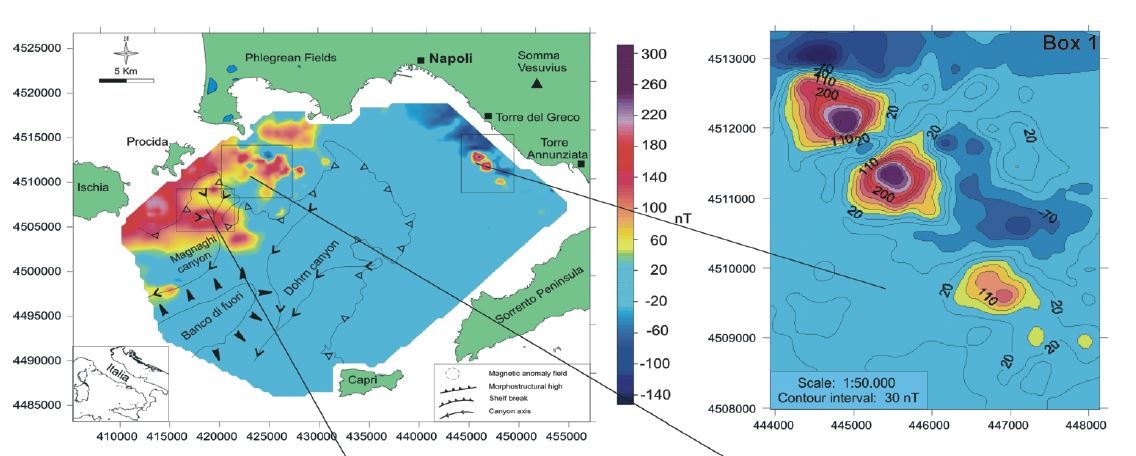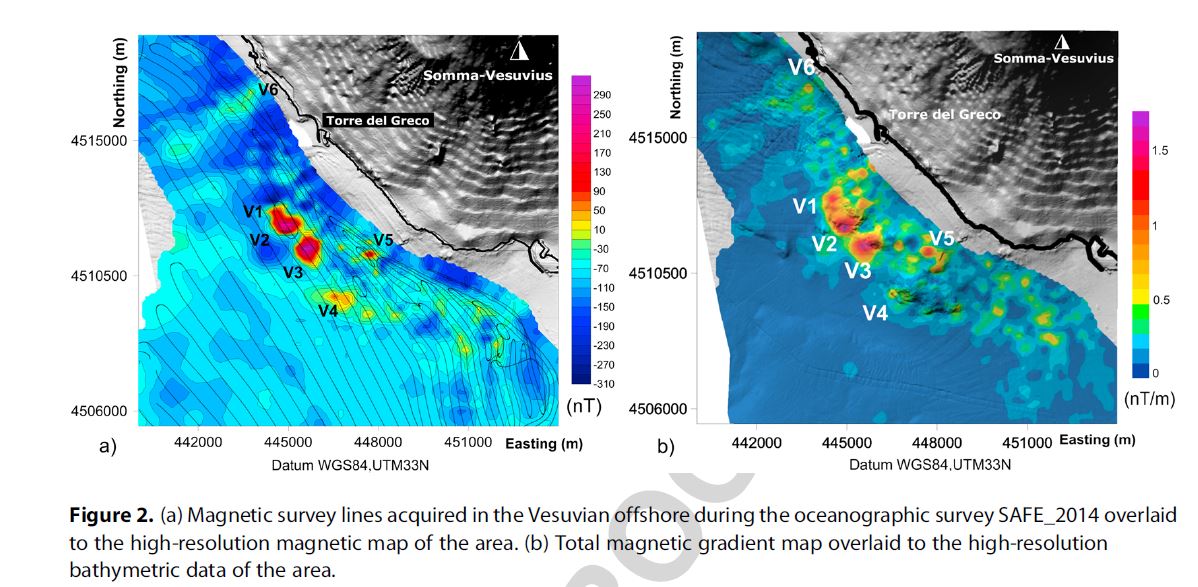HOME PAGE
SCOPERTI SEI VULCANI SOTTOMARINI? NON PROPRIO, TRE ERANO NOTI DAL 2005.
By Giuseppe D'Aniello © 2016
30/09/2016
Ebbene si. Tre delle sei
formazioni vulcaniche sottomarine al largo di Torre del Greco e Torre
Annunziata erano già note dal 2005.
Ce ne eravamo resi conto da subito ma, come sempre, abbiamo
voluto approfondire per dare un'informazione completa e corretta.
Abbiamo letto ed analizzato, in forma integrale, due studi: lo studio
pubblicato in questi giorni ed uno del 2005. Cercheremo di
utilizzare una terminologìa semplice e di essere brevi per far
comprendere a tutti.
Dunque, in questo studio del 2005 (Buried
volcanic structures in the Gulf of Naples (Southern Tyrrhenian Sea,
Italy) resulting from high resolution magnetic survey and seismic
profiling in ANNALS OF GEOPHYSICS, VOL. 48, N. 6, December 2005),
condotto con metodi simili a quello annunciato in questi giorni, erano
state rilevate nettamene tre strutture/formazioni vulcaniche.
Eccovi una mappa tratta dallo studio del 2005:

Confrontiamola con una delle mappe dello studio pubblicato in questi giorni (Sub-circular
conduits and dikes offshore the Somma-Vesuvius volcano revealed by
magnetic and seismic data: Conduits and dikes of Vesuvian offshore
Article in Geophysical Research Letters · September 2016).

Notate come solo i vulcani denominati V4, V5 e V6 sono "nuovi" mentre gli altri erano già noti almeno dal 2005.
Abbiamo documentato qui
come da un certo anno (2000 almeno) INGV OV abbia
smesso di monitorare (o, per quanto osservabile, di riportare nei
bollettini) le fumarole sottomarine al largo di Torre del Greco.
Ora apprendiamo che tre
strutture/formazioni vulcaniche erano note dal 2005 ma, per quanto ci
è noto e pubblicato da INGV OV, queste strutture non sono mai
state monitorate. Possibile?
Torniamo allo studio del 2005: in esso viene detto che alcune delle
strutture si sarebbero formate recentemente e che la loro natura
vulcanica è indubbia. Anzi, per una di esse, le strumentazioni
hanno registrato un valore di 500 nT, il massimo osservato in tutto il
Golfo di Napoli.
Ma bastava leggersi integralmente lo studio di pochi giorni fa per capire che i vulcani scoperti erano tre e non sei.
Leggete cosa si dice in esso:
"[...] Some of these
anomalies (i.e., V1, V2, and V3 in Figures 2 and 3) were already known
from previous studies [Secomandi et al., 2003;Aiello et al., 2001],
whereas others (V4, V5, and V6) are here reported for the first time".
Addirittura dagli anni 2003-2001 vi erano evidenze di strutture "anomale" nel mare antistante Torre del Greco/Torre Annunziata.
Eppure, sembrava quasi che nessuno sapesse nulla: leggiamo di Sindaci
che cascano dalle nuvole, per non parlare delle iniziative che ora
(ora!), vengono richieste al Dipartimento di Protezione civile ignaro,
a quanto si legge in giro, dell'esistenza dei vulcani sottomarini.
A Noi di METEOVESUVIO fa rabbrividire
una cosa essenzialmente: il mancato monitoraggio dell'area nonostante,
ribadiamo, almeno dal 2005 vi fosse uno studio come quello qui
evidenziato.
Eccovi ora, a stralcio, i passi che abbiamo ritenuto più
significativi dello studio del 2005 (formattazione testo Nostra):
"
[...] The widest of these vents
extends for about 7.5 km offshore of the Torre del Greco town; its top
shows three main peaks (CDP 600-1300), correlating to the maximum
values of the recognized anomalies (fig. 4). The above mentioned
structures correspond to a magnetic anomaly field composed of several
anomalies, reaching maximum values of 500 nT (fig. 2 and 4). This
represents one of the maximum values of the observed anomalies in the
Gulf of Naples.[...]
[...]Large volcanic,
acoustically-transparent, dome-shaped structures, were recognized near
the top of the Campanian Ignimbrite unit, fossilized by Pleistocene and
Holocene coastal and marine sediments and warping the Campanian
Ignimbrite unit (fig. 5). The structures are similar to those
previously described on Line 4 (fig. 4). The occurrence of a magnetic
anomaly, in the order of 40 nT, in one of the dome-shaped structures,
confirms its volcanic nature. The age of the domes could be very recent,
nevertheless they are fossilised by about 300 m of Holocene sediments.
Normal faults bound a basin between the two domes, where sediments
significantly thicken.
The same seismic units were
recognized on Line 6 (fig. 6), which runs in NE-SW direction offshore
of the Vesuvian area (Torre del Greco town) up to the Gulf of
Naples continental slope (fig. 3). The thickness of the Campanian
Ignimbrite seismic unit is of about 100 m, comparable with that of the
Campanian Ignimbrite in the «Trecase 1» well, drilled on
land in the Somma-Vesuvius area (Balducci et al., 1985). During its
deposition the unit probably overlay an inclined paleomorphology, as
evidenced by the landward dipping of the erosional unconformity located
at its base, or alternatively, the unconformity was involved by a
tectonic tilting of the shelf (Milia, 1996). Relic morphological highs
located in the central part of the gulf, occur near to the presentday
shelf break (Aiello et al., 2001b). The
qualitative correlation between the seismic profile and corresponding
magnetic line confirms the volcanic nature of the domeshaped structure
warping the Campanian Ignimbrite unit.
The preferential alignment of
magnetic anomalies and related seismic structures along a NNW-SSE
trending suggest such a structural elongment offshore the volcano
(Aiello et al., 2003), never singled out by previous papers which
evidenced systems of NE-SW normal faults.
These anomalies correlate to
dome-shaped volcanic structures located along a NNW-SSE elongment in
water depths ranging from –80 m and –110 m. These
structures, located in the outer shelf of the Somma-Vesuvius offshore,
are located in some convexities of the isobaths at water depths ranging
from –70 m up to – 110 m.[...]"
Eccovi gli autori dello studio del 2005:
Gemma Aiello (1), Antimo Angelino (1), Bruno D’Argenio (1) (2), Ennio Marsella (1), Nicola Pelosi (1),
Stefano Ruggieri (1) (3) and Agata Siniscalchi (4)
(1) Istituto per l’Ambiente Marino Costiero (IAMC), CNR, Napoli, Italy
(2) Dipartimento di Scienze della Terra, Università degli Studi di Napoli «Federico II», Napoli, Italy
(3) Consorzio tra le Università degli Studi di Napoli
«Parthenope», Stazione Zoologica «Anton Dohrn»,
Istituto per l’Ambiente Marino Costiero, Napoli, Italy
(4) Dipartimento di Geologia e Geofisica, Università degli Studi di Bari, Italy
E quelli dello studio del 2016:
Valeria Paoletti
University of Naples Federico II
62 PUBLICATIONS 342 CITATIONS
Salvatore Passaro
Italian National Research Council
112 PUBLICATIONS 226 CITATIONS
Maurizio Fedi
University of Naples Federico II
214 PUBLICATIONS 1,951 CITATIONS
Ventura Guido
National Institute of Geophysics and Volcano…
174 PUBLICATIONS 3,220 CITATIONS